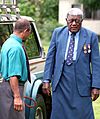Laisenia Qarase facts for kids
Quick facts for kids
Laisenia Qarase
|
|
|---|---|

Qarase in 2004
|
|
| Prime Minister of Fiji | |
| In office 16 March 2001 – 5 December 2006 |
|
| President | Josefa Iloilo |
| Preceded by | Tevita Momoedonu |
| Succeeded by | Jona Senilagakali |
| In office 4 July 2000 – 14 March 2001 |
|
| President | Ratu Josefa Iloilovatu Uluivuda |
| Preceded by | Vacant |
| Succeeded by | Tevita Momoledonu |
| Member for Lau | |
| In office 2001–2006 |
|
| Preceded by | Koila Nailatikau |
| Succeeded by | Office abolished |
| Personal details | |
| Born | 4 February 1941 Vanua Balavu, Colony of Fiji |
| Died | 21 April 2020 (aged 79) Suva, Fiji |
| Political party | Soqosoqo Duavata ni Lewenivanua |
| Spouse | Leba Qarase (?–2020; his death) |
| Children | 5 |
Laisenia Qarase (born 4 February 1941 – died 21 April 2020) was an important political leader in Fiji. He served as the Prime Minister of Fiji from 2000 to 2006. The Prime Minister is the head of the government, like a president or chancellor in other countries.
Qarase became Prime Minister after a difficult time in Fiji. He helped lead the country after a military takeover in 2000. He won two elections, showing that people supported him. However, he was removed from power by the military in 2006.
Qarase was from Vanua Balavu Island, part of the Lau Islands. Many leaders in Fiji have come from this area.
Early Life and Career
Laisenia Qarase was born in 1941 in a village called Mavana. This village is on Vanua Balavu island. He went to school in Fiji, including Suva Boys Grammar School.
After finishing school in Fiji, he moved to New Zealand in 1959. He studied at the University of Auckland and earned a degree in business.
When he returned to Fiji, Qarase worked for the government. He served in different ministries, helping with finance, business, and public service. He later worked in banking. In 1983, he became the first Fijian managing director of the Fiji Development Bank (FDB). He held this important job for 15 years.
After a military takeover in 1987, Qarase was asked to help fix Fiji's economy. He created a plan to support Fijian businesses. However, some parts of this plan faced challenges. There were also disagreements about how some companies were managed.
Qarase had a diverse family background, including Indigenous Fijian, Tongan, and Jewish roots. He was married to Leba Qarase, and they had five children. In his home village of Mavana, he held a traditional leadership title called Tui Kobuco.
Challenges and Political Changes
Laisenia Qarase was re-elected as Prime Minister in 2006. He had said that this would likely be his last term in office. However, his government had ongoing disagreements with the powerful Republic of Fiji Military Forces.
These disagreements led to a military takeover on 5 December 2006. The military removed him from his position. Qarase was sent to his home island of Vanuabalavu. He stated that he would continue to fight for democracy. He also asked for help from other countries, like Australia.
The military warned him not to cause trouble. But Qarase continued to speak out against the military's actions. He compared the new situation to difficult times in other countries' histories.
In 2007, the military leader, Commodore Bainimarama, announced a state of emergency. This meant that special rules were put in place. He claimed that Qarase was spreading false information. He wanted Qarase to stay on his home island.
Qarase later challenged the military takeover in court. The special rules of the state of emergency were eventually lifted.
Elections were planned for 2009, but they did not happen until 2014. Qarase and some other politicians were not allowed to run for office. His political party also had to change its name and initials. Even so, the new party kept many of Qarase's original ideas.
After the military takeover, Qarase faced accusations related to his time in office. In 2012, he was found responsible for misusing his position. He was given a sentence. However, his supporters believed that these accusations were politically motivated. They felt it was because of his opposition to the military-backed government.
Images for kids
See also
 In Spanish: Laisenia Qarase para niños
In Spanish: Laisenia Qarase para niños








